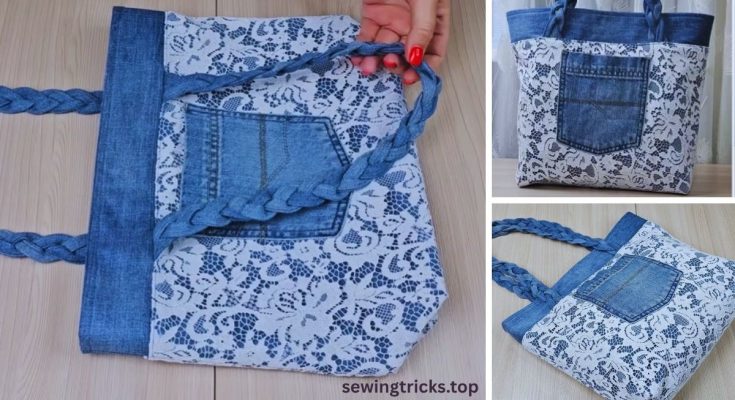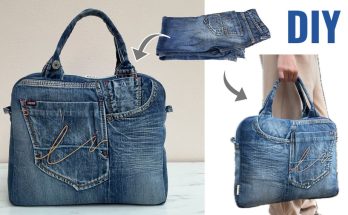What a lovely idea! Combining the rugged charm of denim from old jeans with the delicate elegance of lace creates a truly unique and beautiful bag. This project allows for wonderful creativity, blending textures and styles for a piece that’s both durable and distinctly feminine.
This detailed guide will show you how to sew a medium-sized tote-style bag with a flat bottom, featuring a prominent lace overlay on the exterior and a neat lining. We’ll aim for a finished size of approximately 12 inches wide x 13 inches tall x 4 inches deep (30.5 cm W x 33 cm H x 10 cm D).
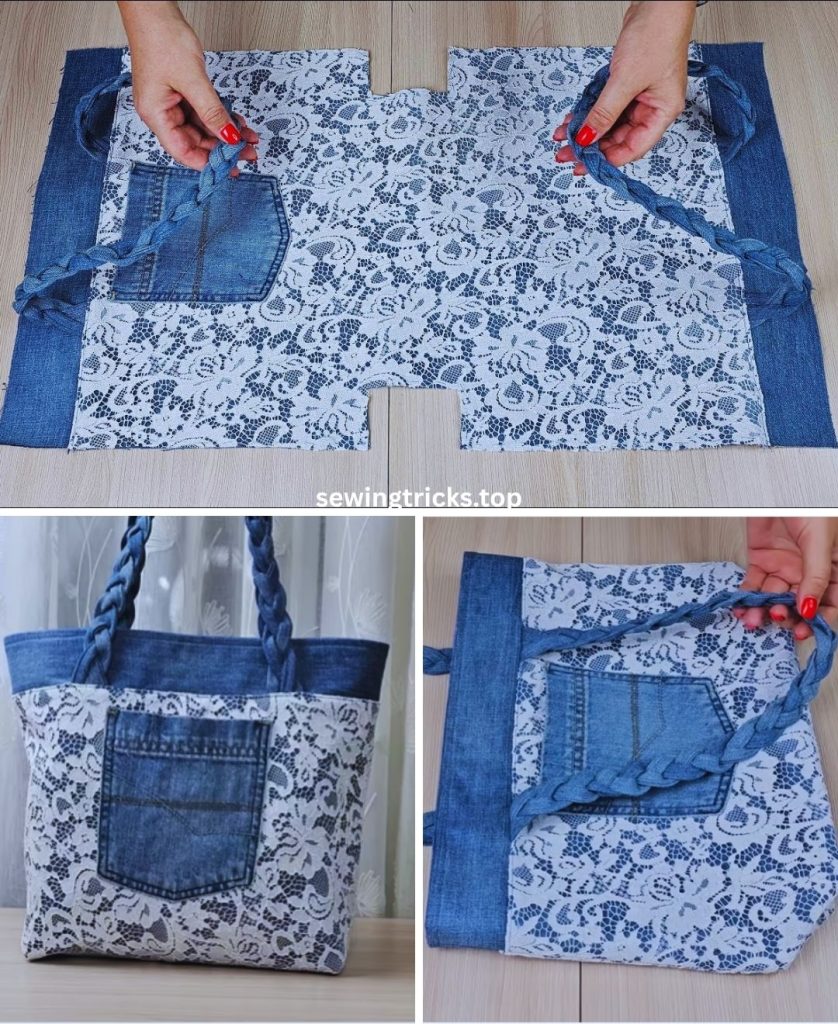
How to Sew a Beautiful Bag from Jeans and Lace with Your Own Hands
I. Planning Your Jeans and Lace Bag
Thoughtful planning helps ensure your project goes smoothly and your finished bag looks fantastic.
- Choose Your Denim Wisely:
- You’ll need at least 1-2 pairs of adult jeans (men’s larger sizes or women’s plus sizes are great).
- Non-stretch or low-stretch denim is highly recommended. High-stretch denim can be challenging to work with for structured projects.
- Ensure your jeans are clean and ironed before you start. Consider lighter washes for a delicate look or darker washes for a bold contrast with the lace.
- Select Your Lace:
- Type: You can use a single piece of lace fabric, lace trim, or even doilies. Think about the aesthetic you want:
- Alençon or Chantilly lace: More intricate and delicate.
- Guipure or Chemical lace: Thicker, more substantial, and often stands out more.
- Cotton lace: Has a lovely, rustic appeal.
- Amount: You’ll need enough to create a prominent decorative panel on the front (and back, if desired) of your bag. For a 12″x13″ bag, aim for a piece that’s at least 10″x10″ or several smaller pieces for a collage.
- Color: White or cream lace creates a classic, soft look. Black lace on dark denim is dramatic. You could even dye white lace to a specific color!
- Type: You can use a single piece of lace fabric, lace trim, or even doilies. Think about the aesthetic you want:
- Lining Fabric: Essential! A lining gives your bag a professional, clean finish, hides all raw seams, and adds durability. Choose a lightweight cotton fabric (like quilting cotton) that complements or contrasts nicely with both your denim and lace.
- Interfacing:Highly recommended! This gives your bag body and helps it stand up on its own.
- Heavyweight Fusible Interfacing (e.g., Pellon 809 Decor Bond or Pellon 71F Peltex II Ultra Firm) is ideal for a sturdy bag.
- Handles: We’ll make fabric handles from your denim for a cohesive look. Alternatively, you could use leather straps or cotton webbing.
II. Gather Your Materials
Having all your supplies ready before you start sewing will make your project run smoothly.
- Old Jeans: 1-2 pairs of clean, ironed, sturdy denim jeans.
- Lace: Approximately 1/4 to 1/2 yard (0.23 to 0.45 meters) of lace fabric, or several yards of wide lace trim/doilies, depending on your design.
- Lining Fabric: 1 yard (0.9 meters) of coordinating lightweight cotton.
- Heavyweight Fusible Interfacing: 1 yard (0.9 meters).
- Matching Thread: All-purpose polyester thread. Consider topstitching thread in a contrasting color (like gold, orange, or beige) for denim seams and fine, matching thread for attaching delicate lace.
- Basic Sewing Supplies:
- Sewing Machine: Your machine should handle thicker fabrics. A walking foot is highly recommended for denim and multiple layers.
- Heavy-Duty Needles: Denim needles (size 90/14 or 100/16) are essential. Keep spares!
- Sharp Fabric Scissors or Rotary Cutter and Mat.
- Measuring Tape or Long Quilting Ruler.
- Fabric Chalk, Frixion Pen, or Mark-B-Gone Pen.
- Plenty of Pins (especially fine, sharp ones for lace) or Fabric Clips (excellent for denim).
- Iron and Ironing Board (crucial for fusing and pressing).
- Seam Ripper (for deconstructing jeans and corrections).
- Temporary Fabric Adhesive Spray or Washable Glue Stick (highly recommended for lace): Helps to hold lace in place while sewing.
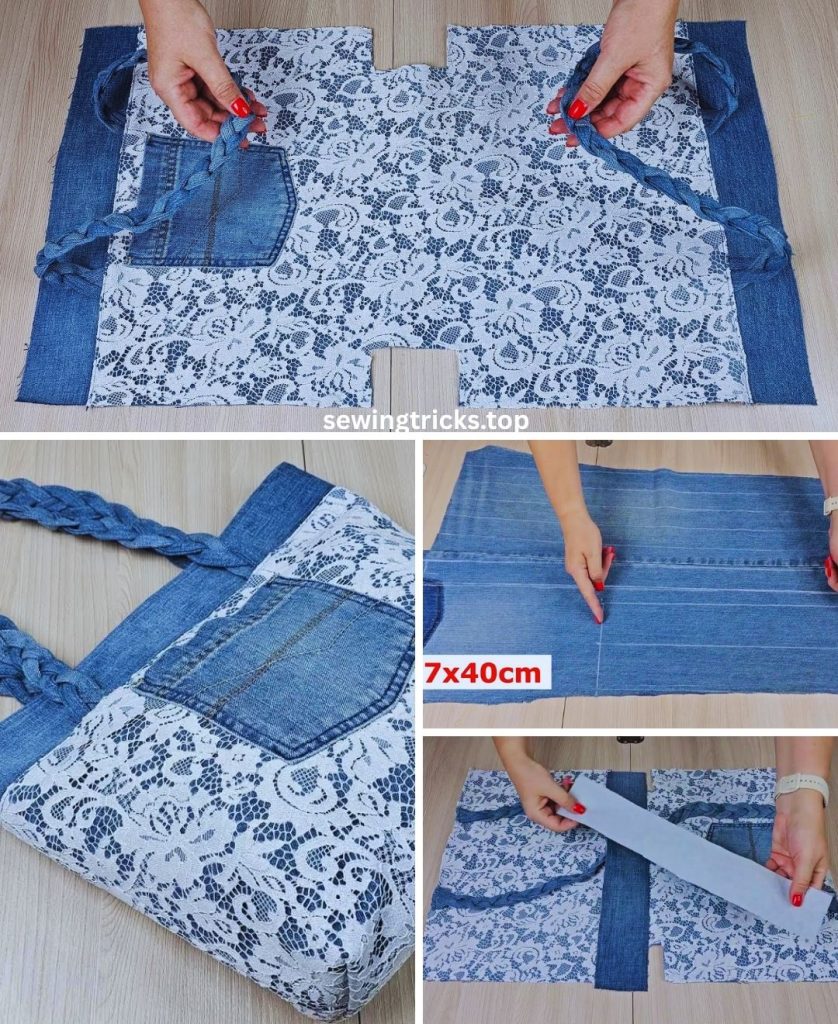
III. Prepare Your Jeans & Cut Fabric Pieces
Precise cutting is vital for a well-proportioned bag. We’ll use a consistent 1/2-inch (1.27 cm) seam allowance throughout this tutorial.
- Target Finished Bag Size: 12″ W x 13″ H x 4″ D (30.5 cm W x 33 cm H x 10 cm D).
A. Deconstruct Your Jeans:
- Cut Off Legs: Lay jeans flat, cut just below the crotch seam.
- Open Leg Seams: Use your seam ripper to open both the inseam and outseam of each leg to get large, flat panels. Iron these flat to remove creases.
- Salvage Features (Optional): Carefully remove back pockets or other details you might want to incorporate.
B. Calculate Your Panel Sizes:
- Main Body Panel Width: Finished Width + Finished Depth + (2 * Seam Allowance) = 12″ + 4″ + 1″ = 17 inches (43.2 cm)
- Main Body Panel Height: Finished Height + Finished Depth + (2 * Seam Allowance) = 13″ + 4″ + 1″ = 18 inches (45.7 cm)
C. Cut Your Fabric Pieces:
- Exterior Denim Pieces:
- Main Body (Front & Back): Cut 2 rectangles, each 17 inches wide x 18 inches high.
- Important Note on Piecing: You will likely need to piece together sections of your opened jean legs to get these large panels.
- How to Piece Denim: Place two denim pieces right sides together, aligning a raw edge. Stitch them with a 1/2-inch (1.27 cm) seam allowance. Press the seam open thoroughly. Topstitch (Highly Recommended!): On the right side, sew two parallel lines, 1/8″ from the seam, using topstitching thread. This mimics authentic jean seams and adds strength and a decorative touch.
- Handle Pieces: Cut 2 rectangles, each 4 inches wide x 25 inches long. (Adjust length for your preferred handle drop). You may need to piece these from denim scraps.
- Main Body (Front & Back): Cut 2 rectangles, each 17 inches wide x 18 inches high.
- Lining Fabric Pieces:
- Main Body (Front & Back): Cut 2 rectangles, each 17 inches wide x 18 inches high.
- Interior Slip Pocket (Optional): Cut 1 rectangle, 8 inches wide x 10 inches high.
- Heavyweight Fusible Interfacing:
- Main Body Panels: Cut 2 rectangles, each 16 inches wide x 17 inches high (1 inch smaller on all sides than your main fabric panels to keep bulk out of the seam allowances).
IV. Let’s Start Sewing Your Jeans and Lace Bag!
General Sewing Tips for Denim and Lace:
- Press, Press, Press: Absolutely crucial! Press seams open after each stitching step to reduce bulk and create crisp results.
- Backstitch: Always backstitch at the beginning and end of every seam.
- Walking Foot: Use it for denim and multiple layers to ensure even feeding.
- Clips: Essential for thick denim layers. Use fine, sharp pins or temporary adhesive for delicate lace.
- Go Slow: Take your time, especially with lace and thick areas.
- Topstitching: Use a slightly longer stitch length (3.0-3.5mm) for denim topstitching.
Step 1: Fuse Interfacing to Exterior Denim Panels
- Take your two Exterior Denim Main Body Panels. Lay each one wrong side up on your ironing board.
- Center one Interfacing piece on each denim panel (it should be 1 inch smaller on all sides).
- Following the manufacturer’s instructions for your specific fusible interfacing, fuse it firmly to the wrong side of the fabric. Press evenly and allow to cool completely. This gives your bag structure.
Step 2: Apply Lace Overlay to Exterior Panels
This is where the “beautiful” part comes in!
- Take one Exterior Denim Main Body Panel (with interfacing fused) and lay it right side up.
- Position your lace piece(s) onto the denim panel. Think about placement: centered, a border along the top or bottom, or a random collage.
- If using lace fabric: You might cut a rectangle of lace (e.g., 10″ x 10″) and center it.
- If using lace trim: You can layer strips of trim, sew them in parallel lines, or create a pattern.
- If using doilies: Arrange them for maximum visual impact.
- Secure the Lace: This is key for neat stitching.
- Use temporary fabric adhesive spray on the back of the lace, or a washable glue stick to lightly adhere the lace to the denim. This prevents shifting.
- Alternatively, use plenty of fine, sharp pins, placing them close to the edges of the lace.
- Stitch the Lace:
- Using matching thread (fine polyester, not topstitching thread), carefully stitch the lace onto the denim.
- If the lace has a decorative edge, you can stitch just inside that edge. If it’s raw, fold under a tiny hem (if possible for the lace type) or use a small zigzag stitch along the edges to secure it.
- For doilies or intricate lace, you can stitch around the main motifs. Go slowly.
- Repeat this process for the second Exterior Denim Main Body Panel if you want lace on both sides of your bag.
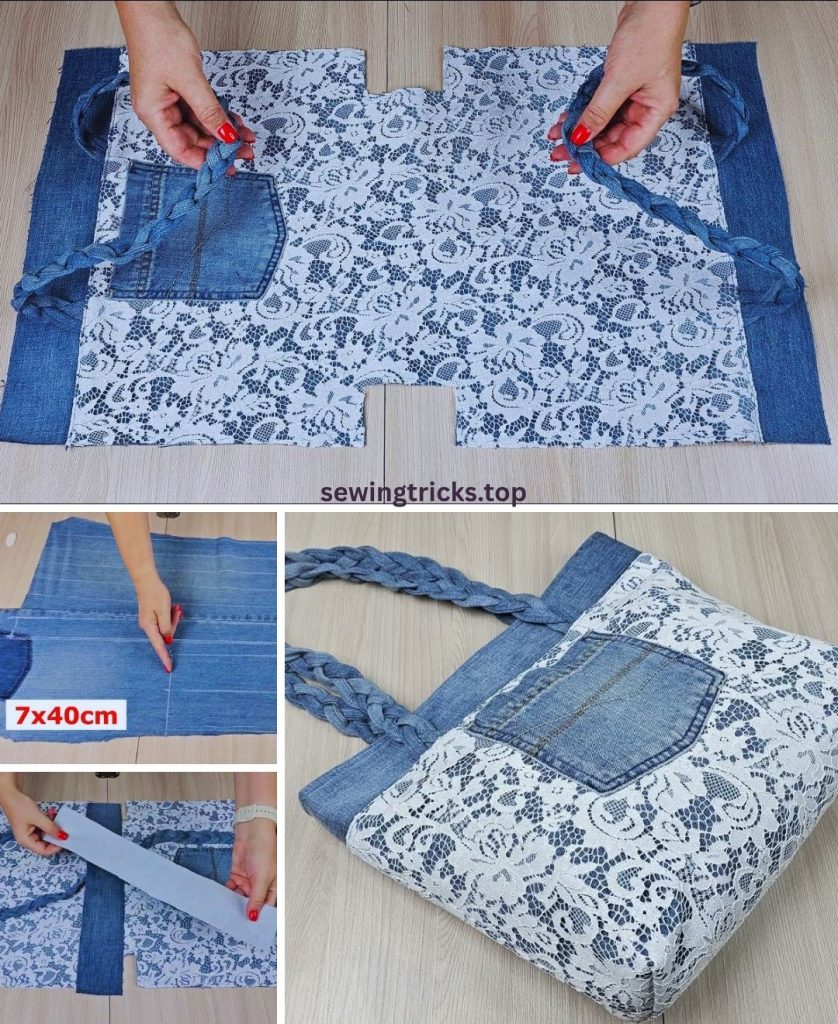
Step 3: Prepare Interior Slip Pocket (Optional)
- Take your 8″ x 10″ pocket piece (lining fabric).
- Fold one long 8-inch edge down by 1/2 inch (1.27 cm) towards the wrong side and press. Fold it down again by another 1/2 inch and press. Stitch this double-folded hem in place, sewing close to the inner fold. This is the neat top edge of your pocket.
- Fold the remaining three raw edges (the two short 10-inch sides and the bottom 8-inch side) in by 1/2 inch (1.27 cm) and press.
- Position this prepared pocket onto the right side of one of your Lining Fabric Main Body Panels. Center it horizontally, and place its top edge about 4-5 inches (10-12.7 cm) down from the top raw edge of the lining panel.
- Topstitch the pocket in place along its two sides and bottom edge, sewing close to the folded edges. Backstitch securely at the beginning and end. For added durability, reinforce the top corners of the pocket opening with a small triangle stitch or extra back-and-forth stitches.
Step 4: Prepare and Attach Denim Handles
- Take one Handle Piece (4″ x 25″). Fold it in half lengthwise, wrong sides together, and press firmly along the fold.
- Open up the strip. Now, fold each long raw edge in towards the center crease you just made, and press again.
- Fold the entire strip in half again along the original center crease. You should now have a long, flat handle that is about 1 inch (2.5 cm) wide, with all raw edges neatly enclosed. Press firmly along the entire length to set the folds.
- Topstitch down both long sides of the prepared handle, sewing about 1/8 inch (0.3 cm) from each edge. This secures all the folds and creates a neat, strong handle. Use topstitching thread if you want that classic jean look.
- Repeat this entire process for the second handle piece.
- Attach to Exterior Bag Panels:
- Lay one Exterior Denim Main Body Panel (with lace applied and interfacing fused) right side up.
- From each side edge, measure in about 4-5 inches (10-12.7 cm) along the top raw edge of the panel. Mark these points with fabric chalk.
- Position the raw ends of one prepared handle on the top raw edge of the panel at your marks. Ensure the handle itself is flat and not twisted. The handle should be pointing downwards into the panel. Clip the ends securely in place.
- Stitch the handle ends in place. For maximum strength, sew a small square (about 1×1 inch) with an “X” inside it (an X-box stitch). Perform this stitching within the 1/2-inch (1.27 cm) seam allowance, close to the raw edge. This reinforcement is crucial as the handles will bear the weight of the bag’s contents.
- Repeat for the second exterior panel with the second handle.
Step 5: Sew the Bag Body (Exterior and Lining)
- Place your two Exterior Denim Main Body Panels right sides together. The handles should be tucked inside the bag. Pin or clip along both side edges and the entire bottom edge.
- Stitch from one top corner down that side, pivot sharply at the bottom corner, stitch straight across the bottom, pivot again, and stitch up the other side to the top corner. Backstitch at the beginning and end of your seam.
- Press all seams open thoroughly to reduce bulk.
- Now, prepare your Lining Fabric Main Body Panels. Place them right sides together. Pin or clip along both side edges.
- CRUCIAL STEP: For the bottom seam of the lining, you must leave an opening! Stitch down one side seam. Then, for the bottom seam, stitch approximately 3 inches (7.6 cm) from one side, then leave a 4-6 inch (10-15 cm) unstitched gap in the middle of the bottom seam. This opening is absolutely essential for turning the entire bag right side out later. After the gap, stitch for another 3 inches (7.6 cm) to reach the other side seam. Backstitch well at the start and end of your stitching around the gap.
- Stitch up the second side seam of the lining.
- Press all lining seams open.
Step 6: Box the Corners (Exterior and Lining)
This step creates the flat, defined bottom of your tote bag, giving it shape and stability.
- At one of the bottom corners of the exterior denim bag, carefully bring the side seam and the bottom seam together, aligning them perfectly. This action will naturally form a triangular shape at the corner.
- Measure from the tip of this triangle inward along the seam line a distance equal to half of your desired bag depth (e.g., for a 4-inch deep bag, you’ll measure 2 inches / 5 cm).
- Draw a straight line perpendicular to the seam at this measured point. (This line will be 4 inches long if your desired depth is 4 inches).
- Clip firmly along this drawn line.
- Stitch precisely along the drawn line, backstitching securely at both ends.
- Trim the excess fabric from the corner, leaving about a 1/2-inch (1.27 cm) seam allowance beyond your new stitching line.
- Repeat this exact process for all three remaining corners: the other exterior corner and both lining corners.
- Result: Both your exterior fabric bag and your lining bag now have structured, flat bottoms. Keep the exterior bag right side out and the lining bag wrong side out.
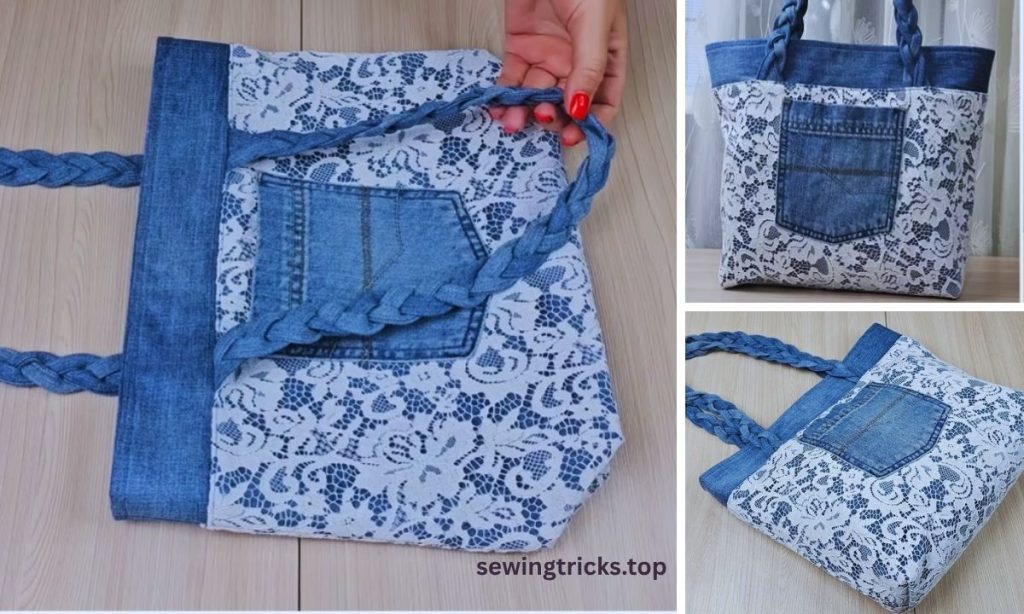
Step 7: Final Assembly (The “Bag-in-a-Bag” Method)
This clever technique encloses all raw edges at the top of your bag, resulting in a very clean and professional finish.
- Carefully insert the exterior denim bag (which is right side out, with handles pointing down inside) into the lining bag (which is wrong side out).
- The right sides of both bags should now be facing each other.
- Align the side seams of the exterior bag with the side seams of the lining bag.
- Align the top raw edges of the exterior fabric and the lining fabric all around the entire opening of the bag. The handles should be tucked well inside between the layers.
- Clip very securely all the way around this top opening, matching up seams precisely.
- Stitch all the way around the entire top opening of the bag, using a 1/2-inch (1.27 cm) seam allowance. Go slowly and carefully, especially over the thick areas where the handles are attached. Backstitch at the beginning and end of your seam.
- Trim Bulk: Carefully trim the seam allowance at the top down to about 1/4 inch (0.6 cm) to reduce bulk inside the top edge for a smoother finish.
Step 8: Turn Your Bag Right Side Out & Finish
This is the incredibly satisfying moment your beautiful bag takes its final shape!
- Remember that opening you left in the bottom seam of the lining in Step 5? Reach through it.
- Slowly and carefully pull the entire bag (exterior, lining, handles – everything!) through this opening until it is completely right side out. Take your time, gently pushing out all the corners and seams for a crisp, well-defined shape.
- Close the Lining Opening: Go to your ironing board. Press the raw edges of the opening in the bottom of the lining under by 1/2 inch (1.27 cm) so they meet neatly. Align these pressed edges and pin or clip them together. Stitch this opening closed by machine (sewing very close to the folded edge for a neat finish) or by hand using an invisible ladder stitch for a truly seamless look.
- Now, gently push the lining down into the exterior bag, ensuring it sits smoothly inside and the top edges are even.
- Final Press & Topstitch: Carefully press the entire top edge of the bag, ensuring the lining is fully tucked inside and isn’t peeking out over the top edge of the exterior fabric.
- For a super polished and durable finish, topstitch all around the entire top opening of the tote, sewing about 1/8 inch (0.3 cm) from the edge. This final topstitching marries the lining to the exterior, helps the bag hold its shape, and creates a crisp, professional look. You can also sew a second row of topstitching about 1/2 inch (1.27 cm) from the top edge for added detail and stability.
Congratulations! Your unique, handmade Beautiful Bag from Jeans and Lace is now complete. You’ve transformed old materials into a functional, stylish, and truly personalized accessory. Enjoy using your sustainable and artistic creation!
What type or color of lace did you choose for your bag, and how did it transform the denim?

